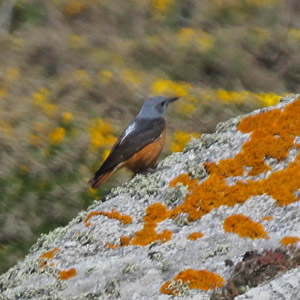Magazine | Analyses
Un Monticole de roche sur l’île d’Yeu (Vendée) le 5 mai 2013

Monticole de roche (Monticola saxatilis) mâle, pointe de la Père, île d’Yeu (Vendée), le 5 mai 2013.
Photographie : Patricia David
Introduction
Le Monticole de roche (Monticola saxatilis) est un passereau migrateur montagnard, nichant généralement au-dessus de 1 500 mètres d’altitude, sur les versants montagneux abrupts, rocheux et secs et dans les alpages, depuis les chaînes ibériques jusqu’au Caucase (et plus à l’est jusqu’en Chine). En France, il se reproduit dans les Pyrénées, le Massif Central, le Jura et les Alpes. Le mâle en plumage nuptial ne peut être confondu avec son dessus bleuté et son dessous orangé.
Le 5 mai 2013, Patricia David et son mari ont fait une étonnante observation : ils ont vu (et photographié) un superbe mâle dans la lande côtière de la pointe de la Père, près du port de La Meule, sur l’île d’Yeu (commune de L’Île-d’Yeu) (Vendée), donc bien loin de son aire de nidification normale. Il était « accompagné » d’un mâle de Traquet motteux (Oenanthe oenanthe). Mais comment un oiseau de haute montagne a-t-il pu arriver sur les bords de l’Atlantique ?
Abstract
The Rufous-tailed Rock Thrush (Monticola saxatilis) is a migratory Passerine breeding generally above 1500 meters on steep, rocky and dry mountain slopes, and in pastures. In Europe, one can find it from the Iberian chains to the Caucasus (and to China). In France, it breeds in the Pyrenees, the Massif Central, the Jura and the Alps. The male in breeding plumage can not be confused. On 5 May 2013, Patricia David and her husband made a surprising observation: they found (and photographed) a beautiful male at the pointe de la Père, near La Meule harbour, on the Yeu Island (Vendee), far from its normal breeding range. It was « accompanied » by a male Northern Wheatear (Oenanthe Oenanthe).
But how could this mountain bird arrive on the shores of the Atlantic?
Poursuivez la lecture de cet article, en vous abonnant dès maintenant !
Découvrez les Archives d’Ornithomedia.com
Pour seulement 10,00 €TTC/an (ou 6,00 € les 6 mois)
Profitez de plusieurs centaines d’articles en accès illimité et sans aucun engagement.
Compléments
Auteurs
Patricia David (e-mail : patricia.m.david@orange.fr) et Ornithomedia.com
À lire aussi sur Ornithomedia.com
Comment arrivent les oiseaux rares ?
Les observations sur Ornithomedia.com
Monticole de roche (Monticola saxatilis)
Ouvrages recommandés
- Le Guide Ornitho de L. Svensson et al
- Carte l’Île d’Yeu/St-Gilles-Croix-de-Vie GPS: IGN.1126OT de IGN (2 novembre 2008)
- Guide des oiseaux de Poitou-Charentes et Vendée de Bruno Dubrac, Serge Nicolle et Hervé Michel
- Le Marais Breton-Vendéen de Frédéric Signoret
- The Migration Ecology of Birds d’Ian Newton
- The Avian Migrant: The Biology of Bird Migration de John H. Rappole
Sources
- Ian Newton (2007). The Migration Ecology of Birds. Academic Press. Pages 282-283.
- Roland E van der Vliet, A (Bert) de Bruin, Jan van der Laan & CDNA (1999). Rare birds in the Netherlands in 1999. http://www.dutchbirding.nl/cdna.php?id=22
- Jochen Dierschke (2007). The status of Black-headed and Red-headed Buntings on Helgoland. British Birds (100), septembre, pages 552–557. http://www.britishbirds.co.uk/search?model=pdf&id=9510




Aucun commentaire sur ce sujet
Participer à la discussion !